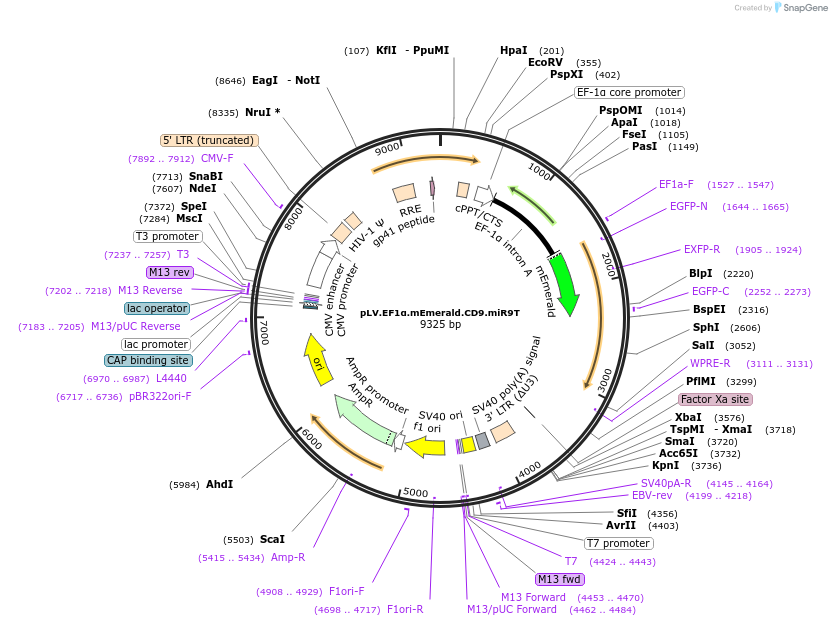pLV.EF1α.mEmerald.CD9.miR9T
(Plasmid
#170452)
-
PurposeLentiviral plasmid that encodes mEmerald-CD9 fusion protein with microRNA 9 tandem cassette to restrict expression to microglia with EF1-alpha promoter.
-
Depositing Lab
-
Sequence Information
Ordering
| Item | Catalog # | Description | Quantity | Price (USD) | |
|---|---|---|---|---|---|
| Plasmid | 170452 | Standard format: Plasmid sent in bacteria as agar stab | 1 | $89 | |
Backbone
-
Vector backbonepLV
- Backbone size w/o insert (bp) 6681
- Total vector size (bp) 9305
-
Vector typeLentiviral
Growth in Bacteria
-
Bacterial Resistance(s)Ampicillin, 100 μg/mL
-
Growth Temperature37°C
-
Growth Strain(s)NEB Stable
-
Copy numberHigh Copy
Gene/Insert
-
Gene/Insert nameCD9
-
SpeciesH. sapiens (human)
-
Insert Size (bp)1431
-
GenBank IDNM_001769.4 NM_001330312.2
-
Entrez GeneCD9 (a.k.a. BTCC-1, DRAP-27, MIC3, MRP-1, TSPAN-29, TSPAN29)
- Promoter EF1a
-
Tag
/ Fusion Protein
- mEmerald (N terminal on backbone)
Cloning Information
- Cloning method Restriction Enzyme
- 5′ cloning site PspXI (unknown if destroyed)
- 3′ cloning site SalI (unknown if destroyed)
- 5′ sequencing primer cctttcgtcttcactcgaggtgcccgtca
- 3′ sequencing primer gaattctgcagtcgacaatcaacc
- (Common Sequencing Primers)
Resource Information
-
A portion of this plasmid was derived from a plasmid made byMichael Davidson (Addgene plasmid # 54029)
-
Article Citing this Plasmid
Terms and Licenses
-
Academic/Nonprofit Terms
-
Industry Terms
- Not Available to Industry
Trademarks:
- Zeocin® is an InvivoGen trademark.
These plasmids were created by your colleagues. Please acknowledge the Principal Investigator, cite the article in which the plasmids were described, and include Addgene in the Materials and Methods of your future publications.
-
For your Materials & Methods section:
pLV.EF1α.mEmerald.CD9.miR9T was a gift from Tsuneya Ikezu (Addgene plasmid # 170452 ; http://n2t.net/addgene:170452 ; RRID:Addgene_170452) -
For your References section:
Plaque associated microglia hyper-secrete extracellular vesicles and accelerate tau propagation in a humanized APP mouse model. Clayton K, Delpech JC, Herron S, Iwahara N, Ericsson M, Saito T, Saido TC, Ikezu S, Ikezu T. Mol Neurodegener. 2021 Mar 22;16(1):18. doi: 10.1186/s13024-021-00440-9. 10.1186/s13024-021-00440-9 PubMed 33752701







